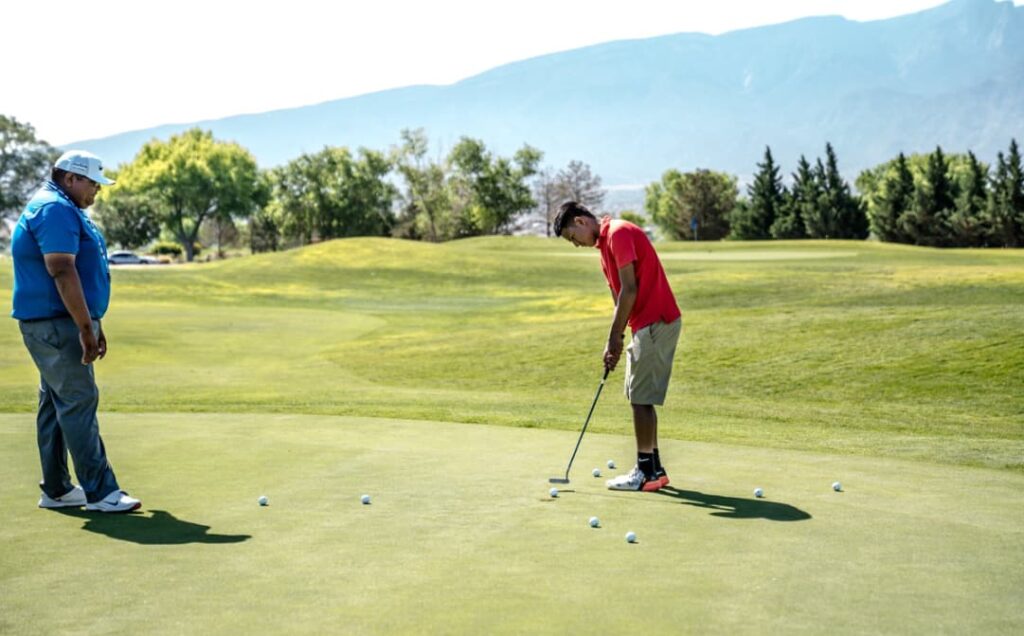Mastering the art of precision on the putting green is crucial for any golfer aiming to lower their score. The ability to accurately gauge and control the distance of a putt separates the proficient players from novices.
This article delves into the complexities of the putting distance formula, offering insights and techniques to enhance your putting skills. Understanding this aspect of golf is essential, whether you’re a beginner or an experienced player looking to refine your game.
How Do You Find The Right Distance On A Putt?
Accurately determining the distance for a putt is a challenging yet essential skill in golf, especially for newcomers to the sport. While devices like laser rangefinders or GPS units provide precise measurements in the fairway, the putting green demands a more nuanced approach. Here are several effective methods to ensure accurate distance assessment for your putt.
Pace Off the Putt
One traditional method used by players to estimate the length of their putt is pacing. By taking regular strides from the ball to the hole, golfers can get a rough idea of the putt’s length, whether a short 15-footer or a more challenging 30-footer. This technique is particularly useful for those calibrating their putting stroke to correlate with specific distances. While not perfectly precise, it’s a valuable tool for players who prefer a more analytical approach.
Walk Around the Entire Hole
For golfers who rely more on intuition and feel, walking around the entire hole can be beneficial. This practice, which involves circling the hole before returning to the ball, helps players mentally process various factors such as slope, break, and distance. This method, often seen among professional golfers, involves more than a simple glance at the putt but a thorough analysis of the green’s characteristics.
Practice More Effectively
Developing a keen sense of distance and control on the green is also a matter of practice. By setting up putts of varying lengths (5, 10, 15, and 20 feet) and marking them with tees during practice sessions, players can fine-tune their stroke for each distance. Regular practice in this manner not only aids in mastering distance control but also reduces the likelihood of three-putts, thus improving overall scores.
Discerning the correct distance for a putt requires focus and practice. Whether you lean towards a more mechanical approach or rely on your sense of feel, consistent practice on putting green will enhance this skill. With dedication, mastering distance control on putts becomes significantly more accessible.
Enhanced Strategies for Precise Putt Measurement
Elevating one’s precision in putting demands an approach that transcends the fundamental methods of pacing and intuition. The following sophisticated strategies offer a roadmap to refine your putting accuracy:
- Conjure the Trajectory in Your Mind: Before executing a putt, engage in a mental exercise where you envisage the ball’s journey towards the cup. This practice of visualizing the ball’s trajectory not only sharpens your perception of the required distance but also aids in anticipating the path it needs to follow;
- Select Points of Reference on the Green: Scout the green for unique characteristics, such as shifts in grass texture or distinct visual markers, to establish points of reference. These markers serve as a guide to measure the distance more accurately, enabling a more calculated approach to your putt;
- Leverage Cutting-edge Golfing Tools: Embrace the advancements in golf technology, such as digital putt analyzers or simulation software. These tools provide invaluable insights into your putting habits, allowing for a data-driven improvement in your technique;
- Craft a Tailored Pre-Putt Routine: Establish a personalized ritual to perform before each putt. This routine not only prepares you mentally but also assists in making consistent distance assessments and aligns your shots with greater precision;
- Experimentation with Various Putters: Recognize that putters come in diverse shapes and sizes, each impacting your feel for the distance differently. Dedicate time to experiment with a range of putters to find the one that aligns best with your putting style. Such experimentation can dramatically alter your perception of distance and improve your putting accuracy.
Adopting these advanced methodologies will significantly enhance your proficiency in estimating distances on the putting green, thereby increasing the likelihood of successful putts.
Integrating Putting Distance Formula into Overall Game Strategy
Understanding and applying the putting distance formula is a game-changer in golf. It’s not just about mastering individual putts; it’s about integrating this skill into your overall game strategy.
Key considerations include:
- Adjusting your approach shots based on green complexity;
- Balancing aggression with caution on longer putts;
- Focusing on developing a smooth, consistent putting stroke;
- Emphasizing the importance of green reading skills.
By incorporating these strategies into your game, you not only improve your putting but also your ability to navigate the course more strategically. For players aiming to break 90 consistently, integrating these putting techniques is crucial. Enhancing your putting game is a significant step towards achieving this milestone.
Conclusion
This guide has explored various facets of mastering the putting distance formula in golf. Each section has provided valuable insights for golfers at all levels, from basic pacing techniques to advanced strategies and the importance of integrating this skill into overall game strategy. As players incorporate these techniques into their practice and play, they will find their putting accuracy and overall golf game improving significantly.
The path to mastering the green is one of patience, practice, and continual learning. With the right approach and dedication, mastering the putting distance formula becomes not just an aspiration but a reality, paving the way for golfers to achieve new milestones, such as consistently breaking 90.
